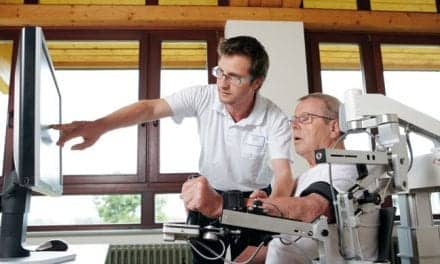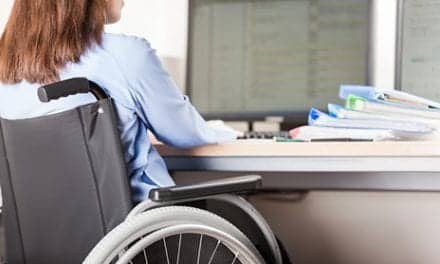Synthesizing technology and functional goals set by patient, family, and therapist helps get stroke patients back on their feet faster and enhances outcomes.
The number of individuals living with some form of disability has increased to an estimated 15% of the world’s population, according to the World Health Organization survey estimates in 2010.1 These statistics have likely increased due to not only the aging population, but also the greater number of individuals living with chronic disease, such as cardiovascular disease and diabetes. These health conditions ultimately predispose individuals to other conditions, specifically stroke. The number of strokes in the United States as of 2014 has been estimated at more than 795,000, with nearly one-fourth of those individuals having suffered from a previous stroke.2
Advances in medicine have allowed for greater survival rates, which have resulted in stroke being the leading cause of adult disability. Disability is defined as the “lack of ability to perform an activity or task in the range considered normal for a human being.”3 Disability is what the patients seen at an acute inpatient rehabilitation facility such as Kessler Institute for Rehabilitation, based in West Orange, NJ, are seeking to minimize. Early rehabilitation services are paramount in reducing long-term disability, preserving independence, and optimizing quality of life. The vast numbers of stroke survivors suffer from disability, similarly to individuals living in the aftermath of progressive diseases such as multiple sclerosis (MS) and Parkinson’s disease, or sustained injury such as traumatic brain and spinal cord injuries.
This being so, the initial evaluation of impairments will ultimately indicate functional limitations and activity restrictions, and is vital in dictating the most applicable course of rehabilitation. Technology has afforded physical and occupational therapists the ability to identify deficits with greater specificity than previously; however, utilizing a clinician’s observational and manual skills continues to be crucial.
EXAMINATION AND EVALUATION
Each patient who arrives at Kessler has been recommended to participate in comprehensive acute inpatient rehabilitation. These recommendations are made to address the patient’s new deficits and to begin the recovery process following an initial neurologic insult or change in disease process. To provide each patient with the benefits of the interventions and the special programs available, a thorough neurological examination must be completed. The standard examination includes: (a) assessments of motor function by testing muscle tone and strength; (b) sensation by testing primary and cortical sensations; (c) coordination and balance; and (d) identifying abnormal reflexes.4
The special tests and measures used during the examination are based on the therapist’s knowledge of the diagnosis and ability to systematically select the most appropriate tools to use. As part of the neurological exam, a thorough gait analysis is conducted by the physical therapist to assess how each of the components (eg, motor function, sensation, coordination, etc) tested separately are mutually impacting a patient’s function. An observational gait analysis allows the therapist to identify abnormal movement patterns not otherwise seen with individual testing. Sophisticated gait analysis systems with the use of walkway sensors, retro-reflective markers, and camera systems provide clinicians with two- or three-dimensional images for a more specific analysis of the temporal-spatial and/or kinematic components of gait. Rollout, portable walkways with built-in sensors provide good flexibility and are engineered to be easily configured in a variety of different pathways. Force platforms and balance systems, too, may be helpful in providing the clinician greater insight into the patient’s symmetry in stance and balance strategies otherwise not as clearly identified. Obtaining subjective reports from individuals and their families is also important.
All of the information acquired from the evaluation enables the therapist to begin synthesizing the qualitative and quantitative components to determine the most appropriate plan of care. While synthesizing the information obtained, it is crucial to utilize a framework, such as the International Classification of Functioning, Disability, and Health (ICF), that outlines not only an individual’s impairments, but also that person’s functional limitations, participation restrictions, and the environmental factors that will either hinder or facilitate recovery and return to home and community.5 From a physical therapist’s perspective, considerable emphasis would be placed on lower extremity impairments in motor function and control, balance, and presence of abnormal tone and how each of these impairments would affect an individual’s independence and ability to access the community through locomotion. To address these impairments, it is important to prioritize the procedural interventions, as well as identify the strategy to be utilized, to reach the goals of the patient and the family.
FUNCTIONAL GOAL SETTING
Once all of the information is collected and synthesized, a prognosis for function is determined and short- and long-term goals are developed. It is the therapist’s job to develop goals that are patient-specific, realistic, and attainable. One of the most important aspects of goal setting is obtaining the goals of the patient and family. It is essential to provide the patient and family with autonomy and active involvement in not only the goal setting, but the rehabilitation process as a whole. With greater involvement, there is an increased likelihood for better functional outcomes, improved patient satisfaction, decreased depression, greater engagement in the treatment program, and improved quality of life reports.6
The greater the involvement in goal setting by the patient and family, the more education is required for them regarding examination findings, including objective results from various outcome measures. The use of objective results may support the examination findings and allow the patient and family to gain greater insight into the patient’s deficits, the therapist’s safety concerns, discharge recommendations, and the patient’s readiness for work or community reintegration. The ultimate goal would be to provide them with the knowledge to, in turn, develop realistic goals for themselves and/or their family members. In order to reach the goals set, there are a number of procedural interventions that are utilized in neurorehabilitation, from conventional services to advanced use of technology. While incorporating advanced technology into treatment, it is crucial that the patient and family are aware of the goals of the specific intervention being utilized.
[sidebar float=”left” width=”500″]
Sidebar: Pre-Owned Rehab Equipment Benefits Stroke and Neuro Care, and Beyond
Therapeutic activities that employ several types of facility-based equipment can be integral in the rehabilitation of patients affected by stroke or a neurological event. As part of a strategy to increase a clinic’s capacity for this patient population—as well as orthopedic patients, athletes, and fitness clients—purchasing pre-owned equipment can be a smart choice.
Perhaps the most convincing reason to consider this option is the cost savings of purchasing pre-owned equipment versus the depreciation of buying new equipment. This was the primary driver in the decision to purchase pre-owned equipment for Salem, Ore-based Northwest Rehabilitation Associates (NWRA), according to Mike Studer, PT, MHS, NCS, CEEAA, CWT.
Studer, who is president and co-owner of NWRA, says the current business environment for PT clinics makes it more important than ever to carefully evaluate the type of equipment that best fits a clinic’s needs. In his own case, Studer says, after evaluating the potential concerns associated with pre-owned equipment—particularly the absence of a new product warranty—the benefits of buying pre-owned made sense.
“I had some reservations about not having the typical protection of a manufacturer’s new product warranty, and I understood the potential risk involved with that. However, I saw that with the cost savings associated with the purchase of pre-owned equipment, the benefits were great enough to outweigh that risk,” Studer says.
A 90-day warranty provided by the supplier for the pre-owned equipment also helped soften Studer’s concerns. “It provided sufficient peace of mind for me,” he says.
NWRA offers services for athletes and orthopedic patients, and hosts a Center for Neurology and Healthy Aging. To properly support the variety of care these programs provide, Studer says, his pre-owned equipment purchases have included items such as stationary bicycles and treadmills. A professional refurbishment was performed on two of the three stationary bicycles Studer bought, which he says offered an additional layer of confidence. When buying pre-owned equipment, Studer points out, it is critical to work with a reputable dealer.
Thus far, Studer has been satisfied with his purchases. He continues to buy pre-owned equipment for NWRA and says he plans additional purchases in the future.
LOWER THE COST OF START-UP
Purchasing pre-owned equipment also can be a smart move for practices just opening their doors, according to Neil Chasan, PT, MMT, owner of Sports Reaction Center (SRC), Bellevue, Wash. Though SRC’s start-up days are well behind it, Chasan says the decision to outfit the clinic with pre-owned gear in the early going helped the business maintain its financial footing.
“When we started out, we had limited resources. The options were to have a partially equipped clinic with new equipment, or a fully equipped clinic with pre-owned equipment. We wanted a fully equipped clinic so we opted for pre-owned equipment right out of the gate,” Chasan says.
The move saved a considerable amount of money and helped improve cash flow, according to Chasan. “We were able to purchase a pretty good range of gear including treadmills, stationary bikes, treatment tables, and exercise machines. We picked up pre-owned ultrasound and e-stim machines as well,” he says.
By the time the new business opened, Chasan estimates SRC had purchased approximately $60,000 worth of equipment for less than 50% of that sum. He says, however, that as the practice grew and new technologies emerged, his purchases gradually transitioned toward new equipment.
“Buying pre-owned in the early stages was very important, though,” Chasan emphasizes. “It was a decision that made getting started both easy and cheap.”
[/sidebar]
TECHNOLOGY IN REHABILITATION
Technology in rehabilitation has provided therapists across the country the ability to prevent secondary complications and enhance recovery, as well as preserve mobility for patients affected by neurological diseases or isolated neurological events. Strokes are so prevalent and with large numbers of survivors, many of whom suffer residual deficits impacting their walking ability. As a result, much of the technology used in rehabilitation has been studied on individuals after a stroke to improve overall function.
One of the most commonly utilized pieces of technology is functional electric stimulation (FES) specifically for stimulation of ankle dorsiflexors to prevent foot drop during the swing phase of gait. Foot drop is typically caused by an insult or injury to the central or peripheral nervous systems resulting in an interruption in the neural connections to the muscles. Ultimately, without the appropriate connections to the foot and ankle, an individual will be less likely to have the ability to ambulate efficiently without the use of an orthotic. The option of using FES to obtain a neuroprosthetic effect may provide individuals with a more normalized gait pattern and with improved balance, compared to those utilizing an ankle foot orthoses.7 Not only does FES provide an individual with a neuroprosthetic effect during walking, but also with the potential to yield a neurotherapeutic effect in improvements in strength following use.8-10 These improvements have been identified in studies where outcome measures specific to walking speed, walking distance, and peak joint angles have been measured.8 Improvements also have been shown in the aforementioned measures with the use of body weight support treadmill training (BWSTT).
BODY WEIGHT SUPPORT AND ROBOTIC GAIT TRAINING
BWSTT is a harness system positioned over a treadmill to enhance safety, to improve the therapist’s ability to provide facilitation, as needed, and to control or increase the patient’s speed. BWSTT provides an environment that promotes automaticity of locomotion, and facilitates reflexive limb movement and activation of the central pattern generators (CPGs) in response to the sensory stimulation provided by the treadmill to facilitate neuroplasticity.11,12 BWSTT innately provides appropriate sensory cues through joint loading and excites neural circuitry for locomotor training while the therapist provides additional cues, if necessary.11 In neurorehabilitation, there is strong emphasis on task-specific training, repetition, and providing an environment to enable the response desired to improve function. In addition to BWSTT, there are a number of alternative technologies with similar benefits that can be used with the vast number of neurologic diagnoses that are seen in rehabilitation centers such as Kessler.
Robot-assisted gait training (RAGT) is frequently utilized among individuals who are affected by incomplete spinal cord injury. However, it also has been used in the chronic stroke, MS, and Parkinson’s disease populations. This type of technology uses a robotic exoskeleton over a treadmill. This allows for increased intensity and reduced demands on the therapist during locomotor training, which would not have been possible without the use of RAGT. The main goal for incorporating RAGT into conventional physical therapy is to improve overall gait kinematics, reorganize neural circuitry, and improve walking function.13 Similarly, a FES bicycle ergometer is utilized to improve aerobic capacity and muscle strength by increasing the intensity to a level otherwise not attainable and stimulating plegic muscles, respectively.14 Safe and functional locomotion requires the motor control, strength, and cardiovascular endurance to withstand the natural demands of walking, all of which have been addressed with the use of the aforementioned technology. However, individuals with balance deficits following a neurologic insult benefit from the use of balance systems to retrain their vestibular systems. Balance retraining is crucial in maintaining and improving mobility within safe parameters especially with progressive diseases such as MS.
Technology in rehabilitation enables clinicians to get their patients walking sooner, have better functional outcomes, and reduce secondary complications. Strong emphasis is placed on patient and family knowledge and understanding of the rationale for use and potential benefits of these interventions, enabling collaboration between the patient, family, and therapist in developing patient-specific and realistic goals. RM
Justine Mamone, PT, DPT, NCS, received her Doctorate of Physical Therapy degree from Quinnipiac University in 2012. She is a graduate of the Neurologic Residency Program at Kessler Institute for Rehabilitation in Saddle Brook, NJ, where she has worked for more than 2 years. Mamone also recently received her NCS from the APTA following the completion of the residency program. For more information, contact [email protected].
References
1. World Health Organization. Summary: World report on disability, 2011. Geneva, Switzerland: World Health Organization; 2011.
2. American Heart Association. Heart disease and stroke statistics—2014 update: a report from the American Heart Association. Circulation. Published online December 18, 2013. Available at: https://circ.ahajournals.org/content/early/2013/12/18/01.cir.0000441139.02102.80. Accessed August 2, 2014.
3. Sturm JW, Dewey HM, Donnan GA, Macdonell R, McNeil JJ, Thrift AG. Handicap after stroke: how does it relate to disability, perception of recovery, and stroke subtypes? Stroke. 2002;33:762-768. Available at: http://stroke.ahajournals.org/content/33/3/762.long. Accessed August 10, 2014.
4. Blumenfeld H. Neuroanatomy Through Clinical Cases. 2nd ed. Sunderland, Mass: Sinauer Associates Inc; 2011:64-74.
5. Atkinson HL, Nixon-Cave K. A tool for clinical reasoning and reflection using the international classification of functioning, disability and health (ICF) framework and patient management model. Phys Ther. 2011;91(3):416-430. Available at: http://ptjournal.apta.org/content/91/3/416.full.pdf+html. Accessed August 10, 2014.
6. Arnetz JE, Almin I, Bergstrom K, Franzen Y, Nilsson H. Active patient involvement in the establishment of physical therapy goals: effects on treatment outcome and quality care. Advances in Physiotherapy. 2004;6(2):50-69. Available at: http://informahealthcare.com/doi/abs/10.1080/14038190310017147. Accessed August 19, 2014.
7. Kluding PM, Dunning K, O’Dell MW, et al. Foot drop stimulation versus ankle foot orthosis after stroke: 30-week outcomes. Stroke. 2013;44(6):1660-9. Available at: http://stroke.ahajournals.org/content/44/6/1660.full.pdf+html. Accessed August 3, 2014.
8. Robbins SM, Houghton PE, Woodbury MG, Brown JL. The therapeutic effect of functional and transcutaneous electric stimulation on improving gait speed in stroke patients: a meta-analysis. Arch Phys Med Rehabil. 2006;87:853-9. Available at: http://www.archives-pmr.org/article/S0003-9993(06)00175-4/pdf. Accessed August 3, 2014.
9. Everaert DG, Thompson AK, Chong SL, Stein RB. Does functional electrical stimulation for foot drop strengthen corticospinal connections? Neurorehabil Neural Repair. 2010;24(2):168-77.
10. Stein RB, Everaert DG, Thompson AK, et al. Long-term therapeutic and orthotic effects of a foot drop stimulator on walking performance in progressive and nonprogressive neurological disorders. Neurorehabil Neural Repair. 2010;24(2):152-67.
11. Sullivan KJ, Brown DA, Klassan T, et al. Effects of task-specific locomotor and strength training in adults who were ambulatory after stroke: results of the STEPS randomized clinical trial. Phys Ther. 2007;87(12):1580-1602.
12. Dietz V. Body weight support gait training: from laboratory to clinical setting. Brain Res Bull. 2009;78(1):1-6.
13. Tefertiller C, Pharo B, Evans N, Winchester P. Efficacy of rehabilitation robotics for walking training in neurological disorders: a review. J Rehabil Res Dev. 2011;48(4):387-416. Available at: http://www.rehab.research.va.gov/jour/11/484/pdf/tefertiller484.pdf. Accessed August 11, 2014.
14. Janssen TW, Beltman JM, Elich P, et al. Effects of electric stimulation-assisted cycling training in people with chronic stroke. Arch Phys Med Rehabil. 2008;89(3):463-9. Available at: http://www.archives-pmr.org/article/S0003-9993(07)01755-8/pdf. Accessed August 11, 2014.





